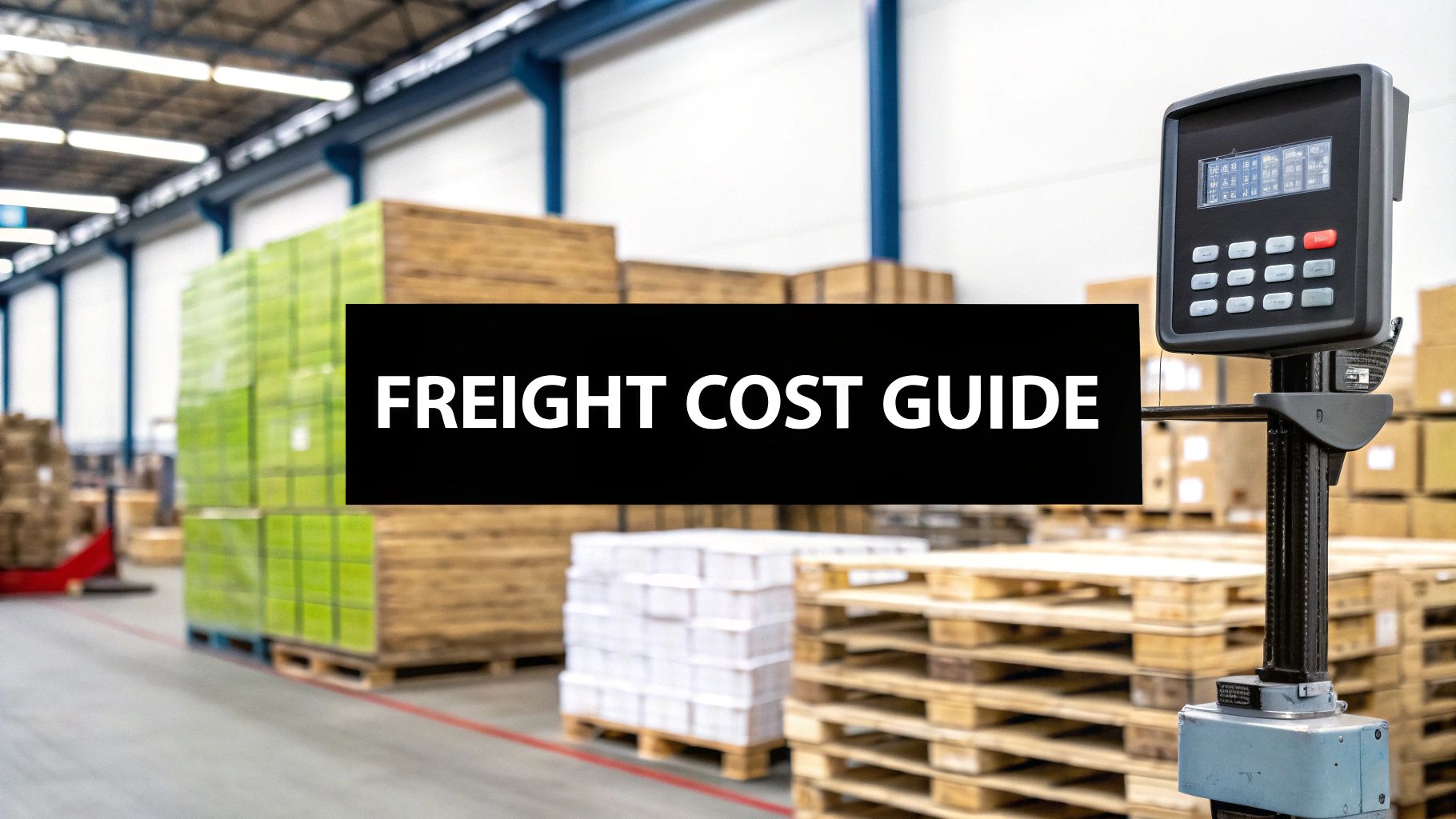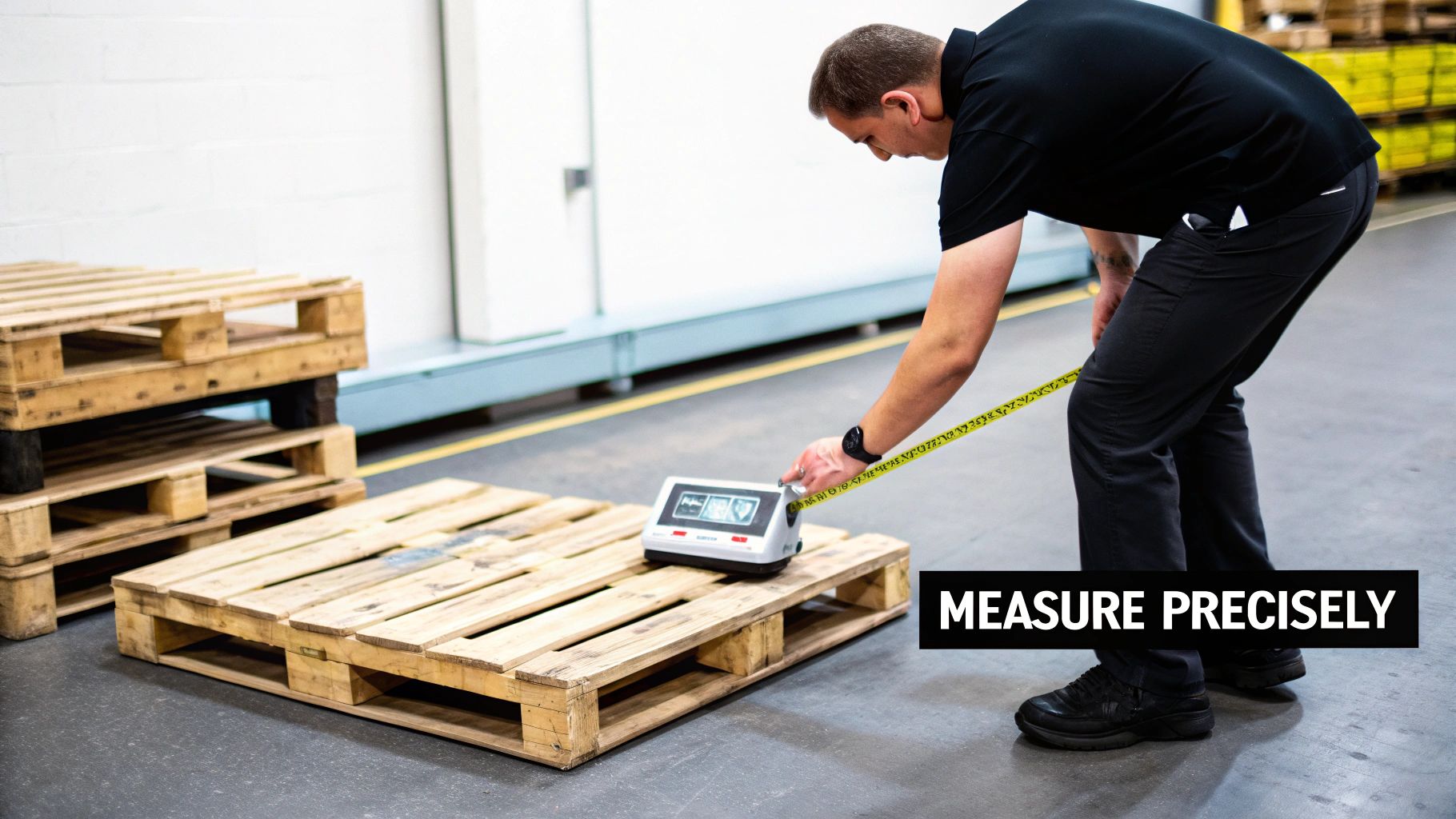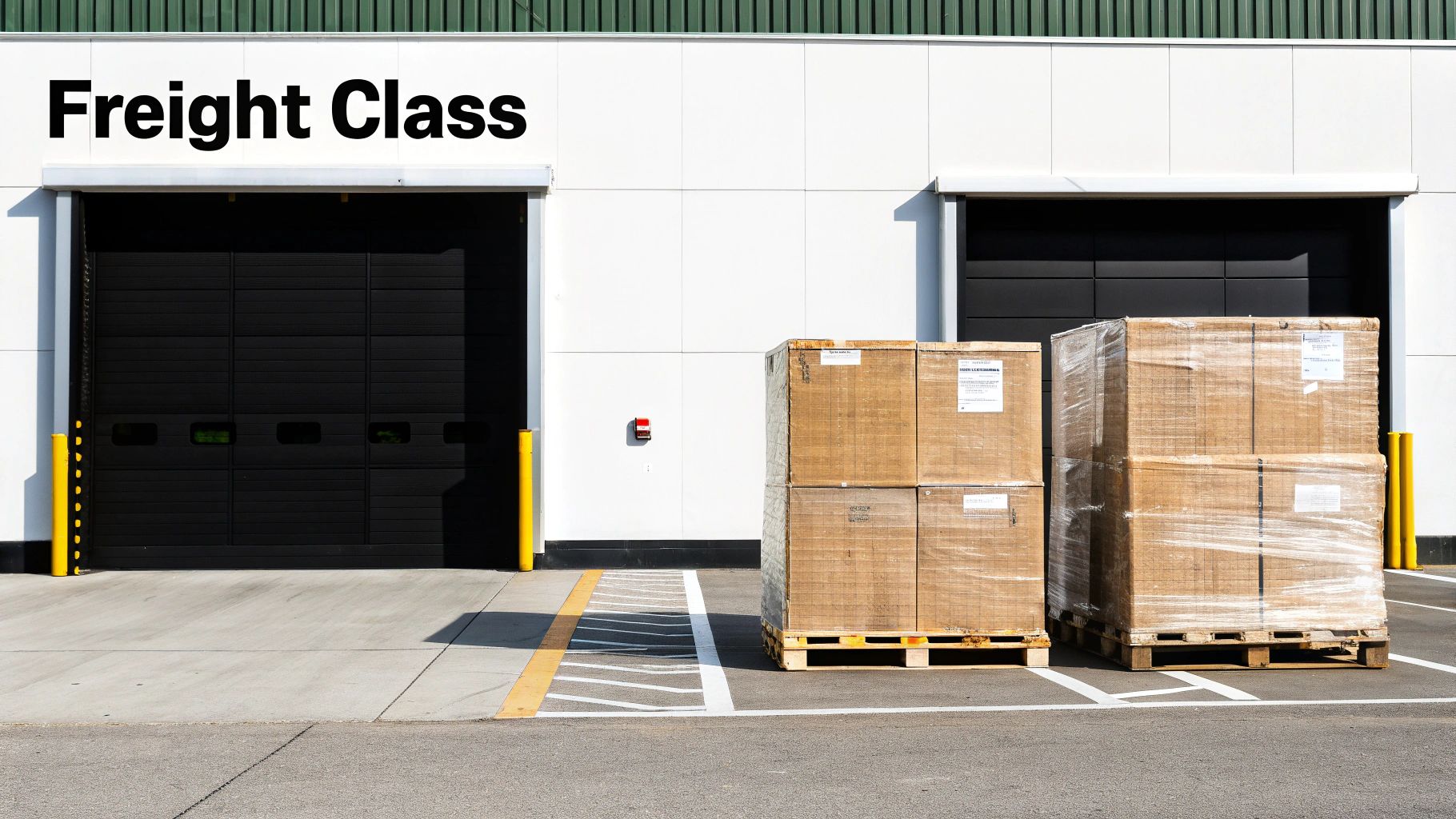Learn how to calculate freight charges with our practical guide. We break down the key factors like freight class, density, and fees for accurate quotes.

Figuring out your freight charges might seem like trying to solve a complex puzzle, but it's not as intimidating as it looks. At the end of the day, it all comes down to a pretty simple formula: the carrier's base rate plus any applicable surcharges and accessorial fees.
The starting point for that base rate? That's all about your specific shipment—its weight, dimensions, and where it's going.
Let's break down how to calculate freight charges. Honestly, once you understand the key pieces of the puzzle, it becomes a lot more manageable. Every single freight bill is built from just a handful of essential details.
Before you can even think about getting a quote, you need to have your shipment's vitals ready to go.
Think of it as your pre-shipping checklist. The absolute must-haves are:
Here's something that often surprises people new to freight: a heavy, dense pallet can actually be cheaper to ship than something light and bulky. Why? It all comes down to shipment density.
Density is just a measure of how much space your freight takes up in the truck relative to how much it weighs. Carriers use this calculation to help assign a freight class, which is a standardized system that classifies all shippable goods.
A lower freight class (think Class 50 for super-dense stuff like steel bars) is much cheaper to ship than a higher freight class (like Class 400 for something light and fragile like ping pong balls). Nailing your freight class is crucial if you want to avoid surprise charges and billing adjustments down the line.
To get the full picture of all the moving parts, checking out a detailed guide on how to calculate shipping costs for your business can give you some great foundational knowledge.
This infographic gives you a nice visual of how all these details come together to form your final price.

As you can see, getting your shipment details right from the start is the bedrock of an accurate freight quote. We're about to walk through each of these elements one by one, so you can feel confident in managing your shipping budget and sidestepping those pesky unexpected costs.
Alright, let's get down to the brass tacks. Before you can even think about getting a freight quote, you need to know exactly what you're shipping. This isn't the time for guesstimates—getting these details right from the start is the single most important thing you can do to avoid surprise charges later.
Think of it this way: carriers are sticklers for detail. They have certified scales and fancy dimensioning machines that will catch any little discrepancy. If what they measure doesn't match what you quoted, you're looking at billing adjustments and extra fees. Let's make sure the price you're quoted is the price you actually pay.
Precision is everything here. You have to measure your shipment after it’s completely packed, stacked on the pallet, and shrink-wrapped. Basically, measure it in the exact state the driver will see it.
Always round up to the nearest inch. And a quick heads-up: if any part of your product hangs over the edge of the pallet, that overhang absolutely must be included in your final length and width. For more on how pallet sizes can impact your shipment, check out our guide on shipping pallet dimensions.
Tired of manual measurements and calculations? Let us handle the complexity for you.
Just like with dimensions, you need the gross weight. We're talking about the total weight of everything—the product, the boxes, the packing peanuts, the shrink wrap, and yes, the pallet itself. A standard 48" x 40" pallet can weigh anywhere from 30 to 48 pounds, and forgetting to add that is a rookie mistake that will earn you an instant billing adjustment.
If you don’t have a commercial scale handy, it’s worth paying a small fee at a local shipping center or weigh station to get it done right. That small investment can save you a much bigger headache down the road.
Pro Tip: Whatever you do, don't just pull the product weight from the manufacturer's website. That number almost never includes the pallet and all the packaging, which easily adds a surprising amount to the total billable weight.
Okay, with your final dimensions and weight in hand, it's time to calculate your shipment's density. For LTL shipping, this number is a huge deal because it's a key factor in determining your freight class, which directly impacts your cost.
Here's the simple math:
That final number is your density, measured in pounds per cubic foot (PCF). Trust me, this little calculation is one of the most powerful pieces of information you'll have when it comes to controlling your freight costs.
If you’re shipping LTL, you're going to hear the term "freight class" a lot. And for good reason—it's one of the biggest factors driving your final bill. Getting a handle on this system is absolutely crucial if you want to calculate your freight charges accurately.
Think of it as a standardized pricing category for everything that can be shipped. It’s a way to make sure carriers are paid fairly for the space your cargo takes up and the risk they assume by hauling it.

The whole system is managed by the National Motor Freight Classification (NMFC), which groups items into 18 different classes. These range from a low of Class 50 to a high of Class 500.
The basic rule is simple: the higher the freight class, the higher the shipping cost. Nail this, and your quotes will be accurate. Get it wrong, and you're looking at some painful billing adjustments from the carrier later on.
So, what actually goes into figuring out your shipment's class? It all comes down to four key characteristics that tell a carrier how easy—or difficult—your freight is to move.
Getting your freight class right isn't just about avoiding extra fees; it’s about building a shipping budget you can actually rely on. I've seen it happen—misclassifying a shipment is one of the fastest ways to watch a profitable delivery turn into a loss.
For a more detailed walkthrough, check out our complete guide on how to determine a freight class.
Once you've got a handle on your shipment's weight, dimensions, and freight class, the next pieces of the puzzle are how far it's going and which carrier is moving it. Carriers don't just pick a number; they rely on detailed rate tables, often called "tariffs," that set base prices based on the origin and destination ZIP codes.
But that base rate is just the starting line. It's constantly being pushed and pulled by the simple, powerful forces of supply and demand.

Market forces have a huge say in what you'll ultimately pay. Picture this: a carrier sends a full truck to a small, remote town. If there's very little freight leaving that town, they have to factor in the cost of that truck driving back empty.
This is exactly why shipping into a quiet, rural area often costs more per mile than shipping out of a busy hub like Chicago or Los Angeles, where there's always another load ready to go.
The availability of trucks in a specific lane (the route between two points) is always in flux. A sudden demand surge in one region can pull trucks from another, causing rates in the less popular lane to jump. It's a living, breathing marketplace that can change by the hour.
These daily shifts are precisely why getting a real-time quote is so important—it reflects the market rate at that exact moment.
The shipping mode you pick also brings its own pricing rules to the table. LTL, Full Truckload (FTL), and air freight each have their own unique formulas for calculating charges. FTL, for example, is usually priced by the mile, whereas LTL costs are a more complex blend of class, weight, and distance.
On top of that, major global events can send shockwaves through pricing. The freight world is deeply interconnected, and a problem in one area—like ocean shipping—can quickly spill over and affect trucking and air rates.
Just look at what happened with ocean freight. Container rates were about 140% higher in 2023 than they were back in 2019, thanks to pandemic chaos and clogged ports. You can find more data on these global container freight trends on Statista.com. This kind of volatility shows how external factors, from supply chain kinks to international conflicts, directly hit your wallet.
Getting a feel for these variables—distance, lane balance, and current market conditions—is the key to understanding the "why" behind your freight quote.
Think of your base rate as just the starting line. Once you start learning how to calculate freight charges, you quickly realize the final cost is almost always higher. That's because of a whole world of surcharges and "accessorial" fees.
These aren't just random charges tacked on; they cover the real costs a carrier deals with beyond just driving from Point A to Point B.
The most common one you'll see on every single invoice is the fuel surcharge (FSC). This is a standard fee that goes up and down weekly with the national average price of diesel. It’s not a hidden fee, but it’s a variable one that’s impossible to lock in weeks ahead of time. For a deeper dive, our article explaining the definition of a fuel surcharge is a great resource.
Beyond fuel, you have a whole category of potential add-ons called accessorial fees. These are simply charges for any service performed that isn't part of a standard, dock-to-dock move.
Think you have all the costs covered? Don't let unexpected fees derail your budget.
The key to avoiding invoice shock is to think through the entire pickup and delivery process ahead of time. If you know your delivery location doesn't have a loading dock, you can request a liftgate from the start and see the true cost in your initial quote.
Here are a few of the most frequent accessorials you’ll probably run into:
A common mistake I see all the time is assuming the driver will help unload. Unless you’ve paid for inside delivery or a similar service, the driver's only job is to get the truck to the destination. Always have a plan for how your freight will actually get off the truck.
Once you get a handle on the different parts of a freight bill, you'll need a good system for managing it all. A great next step is learning about efficiently extracting invoice data for freight charges and fees.
While we’ve focused on trucking, it's worth mentioning that air freight is a different beast entirely. Air freight charges are typically calculated by weight (per kilogram) and are heavily influenced by flight capacity and market demand.
For example, in 2025, air freight rates from China to Europe fell by around 12% in a single month to $3.35 per kg due to shifting demand. At the same time, China-to-U.S. rates held steady at $5.57 per kg. This is a perfect example of how variable and fixed costs come together to determine the final price across different shipping modes.

Even with a step-by-step guide, freight shipping can still leave you with a few head-scratchers. Let's tackle some of the most common questions that come up when you're trying to figure out your costs.
Hands down, the single biggest (and most expensive) mistake is getting the weight and dimensions wrong. This one slip-up is behind the vast majority of billing adjustments in the LTL industry.
Carriers have certified scales and dimensioning machines at their terminals, and they check everything. If their numbers don't match yours, you’ll get hit with a billing correction plus a nasty reweigh and inspection fee. That fee can easily add $25 or more to your bill, and that’s on top of the higher shipping cost you now owe.
A simple rule of thumb will save you a world of hurt: always measure and weigh your shipment after it’s fully packaged, shrink-wrapped, and sitting on the pallet, ready to go. Never, ever guess or just use the weight printed on the manufacturer's box.
You don't need fancy software to cut your shipping costs. A little bit of smart planning can go a long way.
Here are a few tactics I've seen work time and time again:
Struggling to find the best rates? Let us do the heavy lifting and find you a competitive price in minutes.
That dreaded moment when the final bill arrives and it doesn't match the quote... it almost always boils down to one of three things.
The first culprit is usually inaccurate information. The quote was based on one weight, set of dimensions, or freight class, but the reality was different. The second is the sneaky addition of an accessorial service—like needing a liftgate at a delivery location that wasn't mentioned upfront.
Finally, sometimes the shipment itself changes after the quote has been locked in. The absolute best way to avoid this headache is to make sure your Bill of Lading (BOL) is a perfect mirror of the details you used to get the original quote. Double-check it before the driver pulls away.